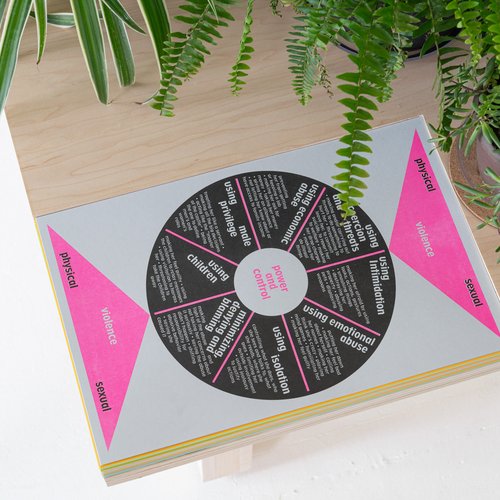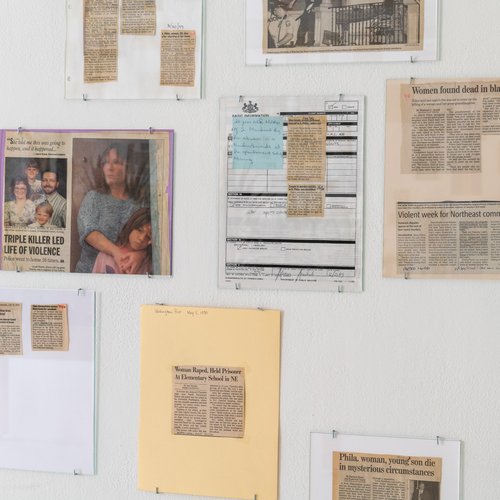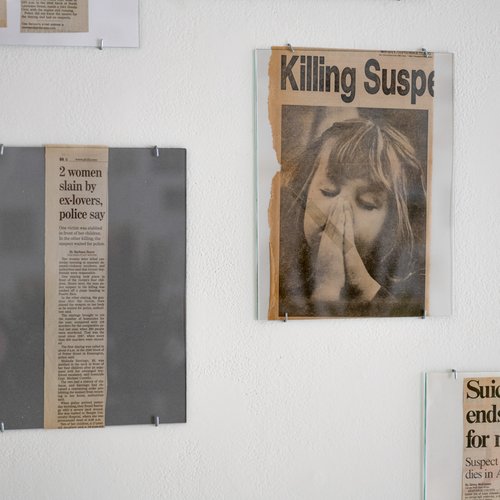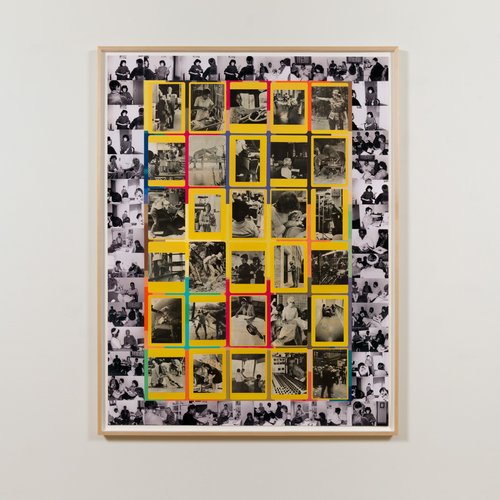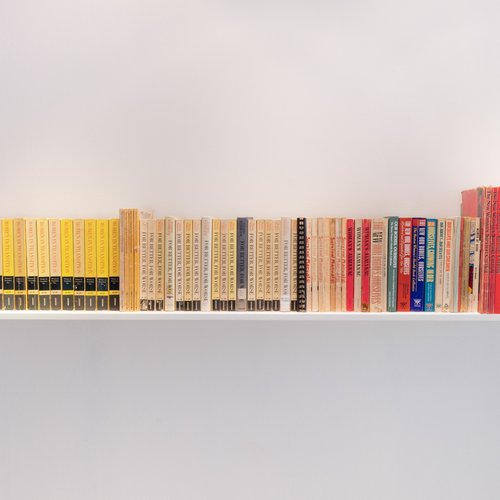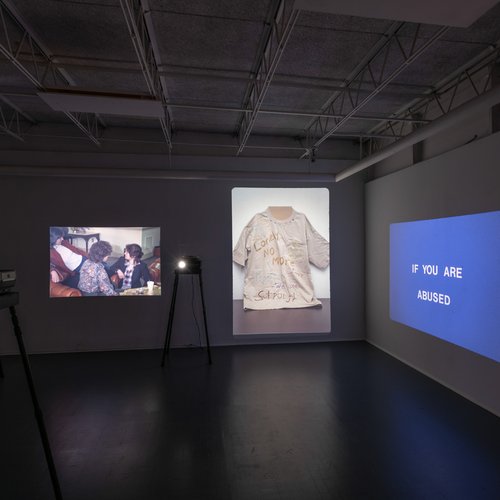A CCA alum helps picture a new ending for survivors
Artist and CCA alum Carmen Winant’s category-defying work illuminates the invisible experiences of women, as well as feminist strategies for survival, revolt, and self-determination in a new exhibition at The Print Center in Philadelphia.
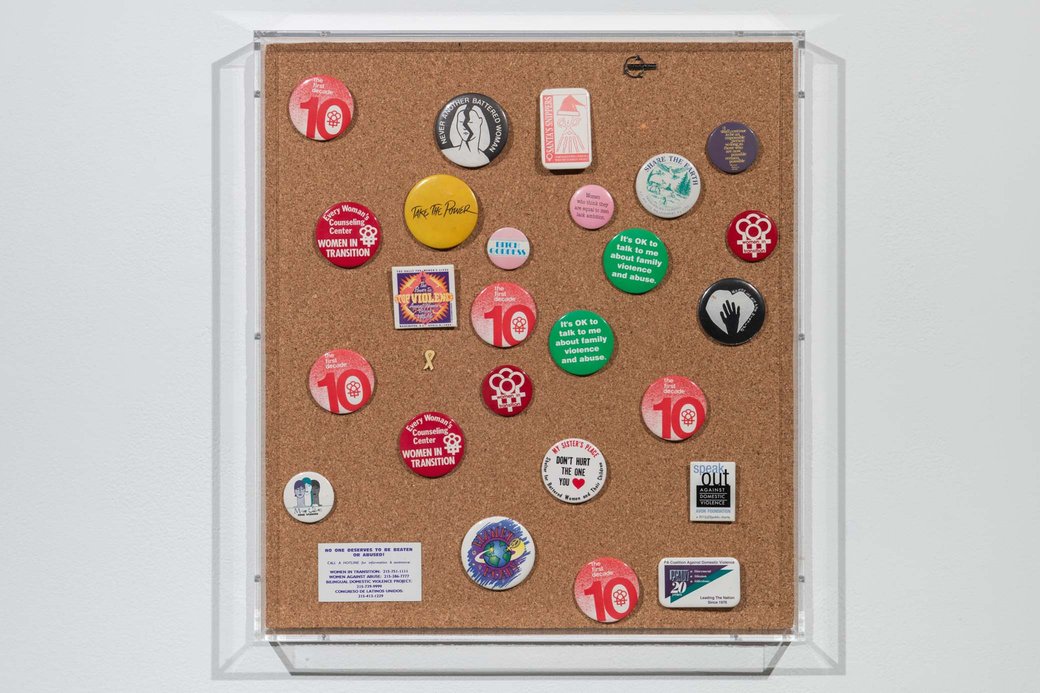
Carmen Winant, Untitled (pin boxes), 2022. Lapel and pin-back buttons on corkboard, 18 x 21 inches. Courtesy of the artist. Commissioned by The Print Center, Philadelphia. Photo by Jaime Alvarez.
Deep in the archives at the Philadelphia nonprofit Women in Transition, decades-old photographs and newspaper clippings tell the agonizing brutality of domestic violence.
That’s not the story CCA alum Carmen Winant (MA Visual and Critical Studies and MFA Fine Arts 2011) wanted to spotlight.
Instead, her photography-based exhibition at The Print Center, in Philadelphia’s Rittenhouse Square neighborhood, explores efforts to help women and vulnerable people recover their esteem, agency, and dignity following periods of violence. Winant found those stories in archival materials at both Women in Transition, which empowers survivors of domestic violence and substance abuse, and the National Coalition Against Domestic Violence.
“That is the beating heart of the project, more than anything: to demonstrate the bravery of these women and individuals—the survivors themselves and the staff of these organizations—and the work that goes into giving women and vulnerable people their lives back after gendered violence,” says Winant, an artist and writer who grew up in Philadelphia and lives in Columbus, Ohio.
She delved for months into the archival material, a cornerstone of the exhibition and a broader project that includes a book and events. In the works for more than two years, the joint endeavor includes The Print Center, which is a nonprofit gallery, and the Pew Center for Arts & Heritage, which provided a roughly $250,000 grant.
The exhibition, A Brand New End: Survival and Its Pictures, is open to the public through July 16 at The Print Center in Philadelphia.
“Archival material surprises you and takes you in directions you haven’t anticipated,” Winant says. “Part of the creative process was remaining open to that surprise and not necessarily predetermining what you’ll find or the shape it will take.”
Developed as a collaboration with Print Center curator Ksenia Nouril, the exhibition represents the fullness of life for survivors and their supporters—travel, art, parties and “everything in between,” Winant says.
“Violence and abuse mark us all in different, sometimes-indelible ways,” she says. “The process of healing, and attempting to heal, differs for every survivor.”
Nouril casts the exhibition as “true to the uniqueness” and diversity of survivorship and its advocates.
“Carmen and I expected to see certain kinds of images in the Women in Transition archives: stereotypical images of women with black eyes, broken noses, shattered plates and glasses on the floor. We saw those things, but we saw so much more,” Nouril says. “The stereotypical images are the minority. The majority show the empowerment that exists in so many forms.”
The book stemming from the project, due for release in the fall, will incorporate responses to imagery from those “who are working with or adjacent to this material in and outside the arts,” Nouril adds. She calls the project transformative in scope and approach, with its combination of research, the arts, and social service.
For Winant, a faculty member at Ohio State University, the effort echoes her creative interest in “operating in a realm of existing material and not making new things.”
“When I was in art school, I felt like I needed to make new things—‘New’ with a capital ‘N,’” she says. “Increasingly, it’s become really important to me to find the substance of the work in interpersonal relationships—and not to make ‘more’ and ‘new’ in a world that already feels like we’re sort of drowning in more and new.”
The exhibition isn’t so much a documentary as it is an animation of archives, including through the collages and other renderings that she created, Winant says. Nouril describes the project as an advancement of Winant’s signature materials and style of work.
“Carmen has taken risks with the content, with the partners, and with the installation itself,” she says. “This project will lift her practice, her methods, and where she’ll go next.”
Published on June 21, 2022
